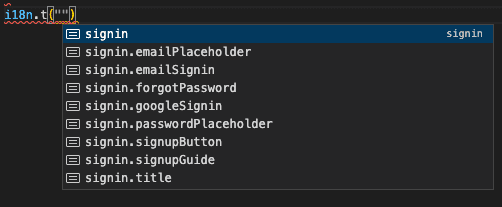React Native에서 i18n(다국어지원)을 설정하는 방법에 대해서 알아보겠습니다.
react-native-localize, i18n-js를 사용합니다.
설치하기
yarn add react-native-localize
yarn add i18n-js
cd ios
pod install0.60이상 버전을 사용하는 경우 위 명령어만으로 충분합니다.
그 아래 버전을 사용하는 경우 참고 링크를 따라 수동으로 링크해주세요
시작하기
아래 사진과 같이 5개의 파일을 생성할겁니다. 각 파일 내용은 다음과 같습니다.

-
locales/en.ts
const translation = { home: { title: 'Home', description: 'this is home screen', }, }; export const en = { name: 'en', translation, }; -
locales/ko-KR.ts
import { en } from './en'; const translation: typeof en.translation = { home: { title: '홈', description: '여기는 홈스크린입니다.', }, }; export const koKR = { name: 'ko-KR', translation, }; -
locales/index.ts
export * from './en'; export * from './ko-KR'; -
types.ts
type Primitive = string | number | bigint | boolean | undefined | symbol; // To infinity and beyond >:D export type PropertyStringPath<T, Prefix = ''> = { [K in keyof T]: T[K] extends Primitive | Array<any> ? `${string & Prefix}${string & K}` : | `${string & Prefix}${string & K}` | PropertyStringPath<T[K], `${string & Prefix}${string & K}.`>; }[keyof T]; -
index.ts
import { I18n, TranslateOptions } from 'i18n-js'; import * as Localize from 'react-native-localize'; import * as translations from './locales'; import { PropertyStringPath } from './types'; const getTranslations = () => { return Object.values(translations).reduce( (acc, curr) => ({ ...acc, [curr.name]: curr.translation }), {} ); }; class I18nProvider { private _i18n: I18n; constructor() { const locales = Localize.getLocales(); this._i18n = new I18n(getTranslations()); this._i18n.defaultLocale = 'en'; if (Array.isArray(locales)) { this._i18n.locale = locales[0].languageTag; } this._i18n.enableFallback = true; } t( scope: PropertyStringPath<typeof translations.en.translation>, options?: TranslateOptions ) { return this._i18n.t(scope, options); } } export const i18n = new I18nProvider();
활용하기
import React from 'react';
import { View, Text } from 'react-native';
import { i18n } from './i18n';
export default function HomeScreen() {
return (
<View>
<Text>{i18n.t('home.title')}</Text>
<Text>{i18n.t('home.description')}</Text>
</View>
);
}설명
-
locales
locales 경로에는 지원할 언어별 모듈들이 있습니다. 새로운 언어를 대응하고 싶은 경우 여기에 추가해주시면 됩니다.
type설정을 통해 en에 존재하는 translation들이 다른 언어들에도 모두 존재하도록 강제했습니다.
-
type.ts
PropertyStringPath는 object type을 입력하면 property를.으로 이은 string literal type을 반환하는 Generic입니다.i18n.t함수에서 존재하지 않는 scope를 입력하지 않도록 제한해줍니다.아래 스크린샷처럼 VScode의 자동완성 기능도 사용할 수 있어 훨씬 편하고 정확합니다.

-
index.ts
I18nProvider클래스를 만들고,i18n-js에서 제공하는 객체는 내부로 숨깁니다.덕분에
t함수의 scope를 우리가 원하는대로 설정할 수 있습니다.


